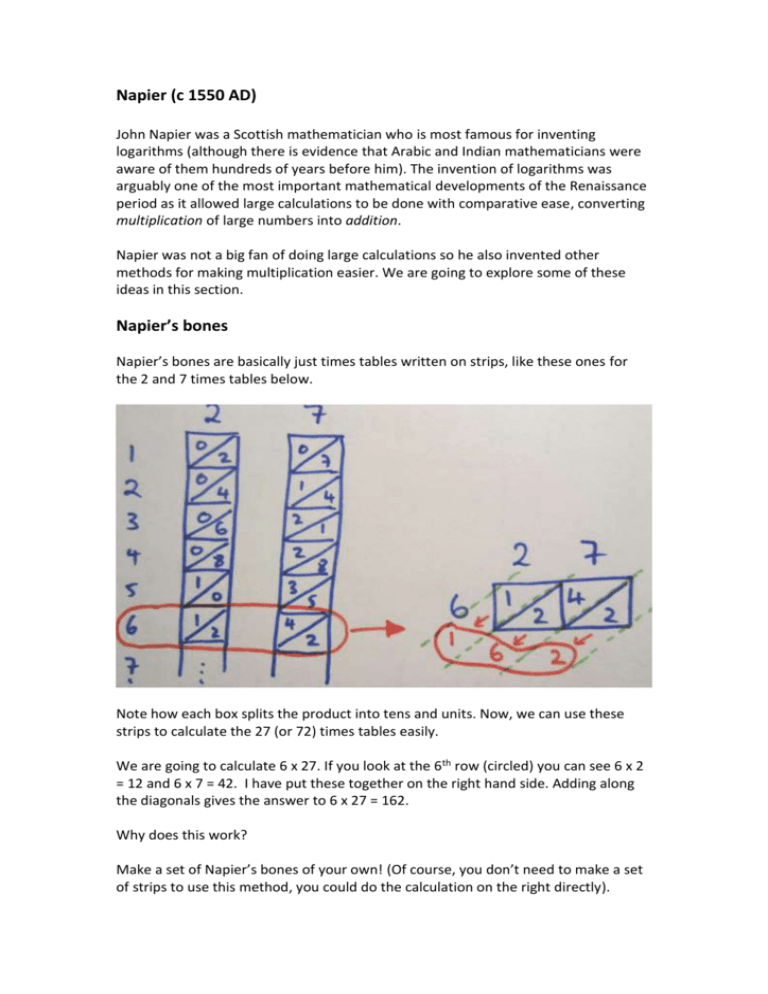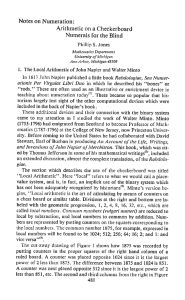Napier - gfsmaths.com
advertisement

Napier (c 1550 AD) John Napier was a Scottish mathematician who is most famous for inventing logarithms (although there is evidence that Arabic and Indian mathematicians were aware of them hundreds of years before him). The invention of logarithms was arguably one of the most important mathematical developments of the Renaissance period as it allowed large calculations to be done with comparative ease, converting multiplication of large numbers into addition. Napier was not a big fan of doing large calculations so he also invented other methods for making multiplication easier. We are going to explore some of these ideas in this section. Napier’s bones Napier’s bones are basically just times tables written on strips, like these ones for the 2 and 7 times tables below. Note how each box splits the product into tens and units. Now, we can use these strips to calculate the 27 (or 72) times tables easily. We are going to calculate 6 x 27. If you look at the 6th row (circled) you can see 6 x 2 = 12 and 6 x 7 = 42. I have put these together on the right hand side. Adding along the diagonals gives the answer to 6 x 27 = 162. Why does this work? Make a set of Napier’s bones of your own! (Of course, you don’t need to make a set of strips to use this method, you could do the calculation on the right directly). Napier’s location numerals Napier knew the fact that all numbers can be expressed as sums of powers of two, like this: 21 = 24 + 22 + 20 This fact is the basis of the binary system, but binary hadn’t been invented when Napier was alive. So he used something called location numerals to represent what we would now call binary. Letting a = 1, b = 2, c = 4, d = 8 and so on, he would write 21 as ace. Try writing some other numbers using location numerals. What are the advantages and disadvantages of such a system? Napier allowed repeats to be used; for example, what would the word add represent? The word add could of course be shortened to ae; Napier called this abbreviation. What is the abbreviated answer to the sum add + ace? Napier used counters on grids to perform these calculations. Addition Consider the sum 29 + 8. Place counters on 29 (= 16 + 8 + 4 + 1 = acde) and 9 (= 8 + 1 = ad) like this: Then we abbreviate as follows: And one final abbreviation leads to: Try some more addition using these grids. How would you adapt this method to perform subtraction? Multiplication Multiplication can be performed on a square grid like this: If each grey square contains the result of multiplying the two letters together, can you fill in the values of all the grey squares? What do you notice? You may have noticed that the diagonals of the grid contain the same values; Napier exploited this fact to perform multiplications on this grid using counters. Here is an example showing the calculation of 5 x 6. The word form of this sum is ac x abc, so place counters on cells where these letters ‘intersect’ like this: Then, as all values on the diagonal are the same, slide the counters along the diagonals to the bottom row as shown below and read off the result (abbreviating if necessary) to give the answer bcde which is 2 + 4 + 8 + 16 = 30. Napier said of this method: “…it might be well described as more of a lark than a labor, for it carries out addition, subtraction, multiplication and division purely by moving counters from place to place.” Can you see how to use it for division? Make a larger grid and have a play with these methods for larger numbers! Logarithms Let’s explore the log button on a scientific calculator – what is it doing? Try different input numbers; which ones give interesting outputs? Try grouping anything interesting together… can you make any conjectures about what the log function does? How about any rules about how log works? The first few values of log x for x = 1, 2, … (rounded to 2dp) are given in the table on the right. x 1 2 3 4 5 6 7 8 9 10 log x 0 0.30 0.48 0.60 0.70 0.79 0.85 0.90 0.95 1 Now make two strips of card as shown below, say 20cm long. The marks correspond to the value of log x scaled up by a factor of 20 (so the mark for 2 = 20 x log 2 = 20 x 0.30 = 6.0cm). If you’re feeling particularly excited by all this, you could mark all the tenths of x as well to get two rulers like the ones below! Now to perform the calculation 2 x 3 = 6 (say) we slide the (left) end of the top ruler to match up with mark 2 on the bottom ruler. Then we read across to mark 3 on the top ruler. The value on the bottom ruler directly below this mark is the answer to the product 2 x 3 (= 6) as shown below: Can you explain why this works? This is called the slide rule; it was based on the Napier’s logarithms, but was not actually invented by him – it wasn’t invented until the 17th century. It was the most commonly used tool in engineering until the pocket calculator became widespread in the 20th century.








